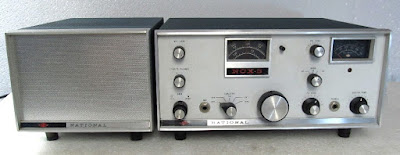So, in our last podcast I asked the group to take a look at two pictures of a mechanical filter that I had recently taken out of its case. These pictures appear above and below. After a discussion of magnetostriction, I asked the group if they could spot anything unusual about this particular device.
I expected many responses. What did I get? CRICKETS!! What is wrong with you guys? Are you spending so much time with software and FT-8 and lines of code that you can't deal with a simple analog question like this? SAD! I guess I will have to answer the question myself. Scroll down.
The diagram below presents the conventional Collins arrangement for a mechanical filter. Note that at the input and at the output there is a coil. This coil creates from the signal a varying magnetic field. Because of the principle of magnetostriction, this field causes the resonators/rod assembly to flex and vibrate, much like a musical tuning fork. At the output, this means that inside the core of the output coil there is a piece of metal vibrating at the signal frequency. This will produce an output signal.
But take a look at my little mechanical resonator. Where are the input and output coils?
THERE ARE NONE! See those little rectangular things at either end? Those are piezo-electric crystals that are MECHANICALLY connected to the disc/rod assembly. So when the signal comes in, it is applied electrically to the piezo material which then physically vibrates. This vibration passes through the filter and to the piezo device at the other end. There the mechanical vibration results in an electrical signal at the output.
So, I think it is time for you all to hang your heads in shame. Perhaps go to the doctor to see if you still have The Knack. Ask for forgiveness from the radio gods.



































